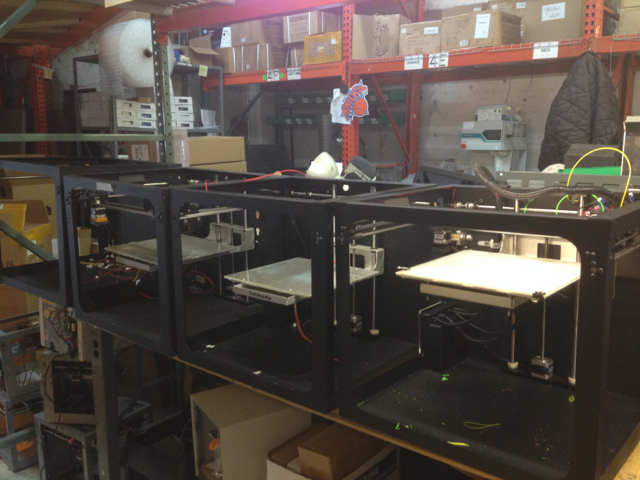
This week former 3D printer manufacturer Solidoodle finally made it formal by announcing they’ve suspended operations permanently. While many could see this coming, what lessons can we gain from this event?
Solidoodle was a well-known manufacturer of inexpensive desktop 3D printers, started by Sam Cervantes, who just happened to be MakerBot’s Chief Operations Officer in 2010. He left to found Solidoodle, perhaps in an attempt to compete with the then-exploding MakerBot.
It worked at first, but as the company expanded they ran into issues. While their designs seemed quite good, they could not work out the kinks in their manufacturing process, as explained by Cervantes in a final blog post:
From 2011 through 2014 we assembled our first four product generations at our own factory in Brooklyn. Soon demand began to grow so large that we felt it would be difficult to scale effectively in Brooklyn, so we sought to partner with an outside assembly factory. We had been largely successful purchasing components in China, so manufacturing our entire product there seemed like the next logical step.
However, this proved to be much more difficult than expected. Despite spending months in China building the partnership, training workers, and inspecting finished units, the factory shipped units which did not live up to our standards. This setback was exacerbated by the 2014 West Coast Port labor dispute and slowdown, which kept hundreds of printers ordered for the Holiday Season from arriving until March. Had they arrived on schedule, we would have had much more time for testing and inspection, and would have realized crucial cash flow much sooner.
We were able to raise some turnaround funding in July 2015, but, despite the support of our investors and the heroic efforts of our team, we were unable to revive sales and return to profitability. As a result, at the end of 2015 Solidoodle ran out of cash, stopped taking new orders, and laid off it’s employees. I’ve now exhausted nearly all of my personal savings in an attempt to achieve the best possible outcome for everyone involved.
It’s a sad tale, but news in the desktop 3D printer market has been grave in recent months, largely due to the diminishing interest in the technology by consumers, locking out most providers from larger-sized markets.
But what lessons can be derived from this announcement and others in the desktop 3D printer space? Let’s identify some key issues.
Typical Consumers Don’t Want 3D Printing – Yet. There are indeed many consumers who do participate in 3D printing, it’s just that they tend to be “DIY” folks able to withstand the challenges of the current state of 3D printing. It turns out that those challenges are far more difficult than a typical consumer would tolerate, and thus the market for existing technologies remains small in the consumer market.
High Volume, Quality Manufacturing Is Very Challenging. As discussed in detail by Solidoodle, it’s easier to manufacture small quantities yourself than large quantities. Usually you must engage with a factory somewhere, typically overseas, to produce the units. However, this step is very difficult as you must produce perfectly detailed specifications that lead to quality results, such that someone that isn’t you can do so reliably. In the case of Solidoodle, it appears they were not able to overcome this challenge in sufficient time before they ran out of cash.
Buyers Don’t Want 3D Printers – They Want Prints. Once the thrill of printing something wears off, the question becomes “what do I print”. If there isn’t a good answer to this question, there’s no point in owning or using a 3D printer. This is a barrier several leading 3D print organizations have realized, and it has led them to focus on very specific application areas, such as education, aerospace, dental, jewelry and a few others where 3D printing technology actually makes practical sense to use. That is a way of answering the “what do I print?” question and transforms the 3D printer from a curiosity to an essential element of business workflow.
Funding Is Very Important. Cash flow is a critical item for 3D print company management, as can be witnessed in the Solidoodle scenario. Run out, and you’re done. But maintaining adequate cash flow during a period of heavy competition, waning consumer interest and during a re-focusing on an application area can stress out anyone’s cash flow. Therefore, it’s critical for surviving companies to have access to funding. This is most often not internally generated, as many companies did not plan for the downturn. Instead, it could come from a wealthy owner, such as the case of MakerBot, XYZprinting and others. Or perhaps it can come from an outside investor. In a few cases, such as Ultimaker, a company may be large enough to generate sufficient cash flow to get through tough times.
Sell To Those With Money. A basic rule in business is to seek out those with cash. That’s another reason why manufacturers have switched to focusing on industrial applications of 3D printing, where large companies are able to effectively spend big cash on 3D printing solutions, simply because the technology makes sense for their business.
Again, it’s disappointing to see Solidoodle disappear, but they have. And so will several others in the upcoming months.
Via Solidoodle

